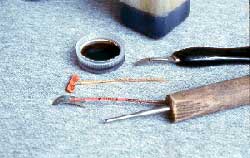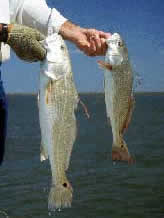Inshore Fisheries Research Section
Tag-and- Release Studies
Why tag-and-release?
 When we tag a fish and release it at the location where it was captured, we are establishing a reference point that enables us assess movement patterns. We can determine if the animal remained within a particular estuarine system and for how long, or if the animal migrated and whether this movement was correlated to seasonal patterns or biological factors such as reproductive behavior.
When we tag a fish and release it at the location where it was captured, we are establishing a reference point that enables us assess movement patterns. We can determine if the animal remained within a particular estuarine system and for how long, or if the animal migrated and whether this movement was correlated to seasonal patterns or biological factors such as reproductive behavior.
When we capture a fish that we had previously tagged, we not only obtain information on movement but also on growth rate. We do this by comparing the length of the fish at the time when it was originally tagged to its length at subsequent recaptures.
Tagging studies also allow us to estimate recreational angler harvest rates and fishing mortality. We can determine how the recreational fishery impacts particular sections of a population such as immature fish or members of the spawning population. Such data can be incorporated into models used to assess the status of the entire stock.
In addition, tag-and-release studies provide indirect advantages. For instance, by involving the angling public in tag reporting, we increase awareness of the finite fisheries resources in our estuaries. If anglers encounter many tagged fishes, or even capture the same tagged fish repeatedly, they become more aware that the resource is limited.
Tag-and-release study on red drum
 We initiated tagging of red drum in South Carolina estuaries in 1985 in response to concerns about the health of the red drum resource throughout the South Atlantic region. As part of the 1984 Fishery Management Plan for red drum, the Atlantic States Marine Fisheries Commission (ASFMC) encouraged states to increase research efforts. Since then, we have been involved in cooperative research with other South Atlantic states (North Carolina, Georgia and Florida) in order to provide as much comprehensive data on the life-history of red drum and to determine the impacts the recreational fishery has on this resource.
We initiated tagging of red drum in South Carolina estuaries in 1985 in response to concerns about the health of the red drum resource throughout the South Atlantic region. As part of the 1984 Fishery Management Plan for red drum, the Atlantic States Marine Fisheries Commission (ASFMC) encouraged states to increase research efforts. Since then, we have been involved in cooperative research with other South Atlantic states (North Carolina, Georgia and Florida) in order to provide as much comprehensive data on the life-history of red drum and to determine the impacts the recreational fishery has on this resource.
Tag-and-release study on striped mullet
Our project has been tagging striped mullet since 1997 in cooperation with researchers from North Carolina, Florida and Georgia. Even though striped mullet are not a popular species among inshore recreational anglers, female mullet that are ready to spawn command a high price since mullet roe is considered a delicacy in some parts of the U.S. and abroad. A substantial commercial fishery exists in Florida and in North Carolina, but resource managers know very little about the life-history of striped mullet or their population dynamics. Consequently, much work needs to be done before striped mullet stocks in the South Atlantic Bight can be accurately assessed.
